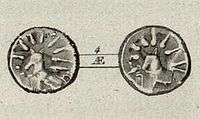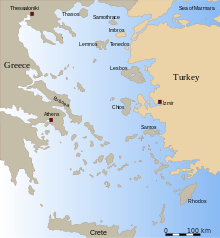Kea (island)
Kea (Greek: Κέα), also known as Tzia (Greek: Τζια) and in antiquity Keos (Greek: Κέως, Latin: Ceos), is a Greek island in the Cyclades archipelago in the Aegean Sea. Kea is part of the Kea-Kythnos regional unit.
Kea Κέα | |
|---|---|
Kea Island | |
 Kea Location within the region  | |
| Coordinates: 37°37′23″N 24°20′12″E | |
| Country | Greece |
| Administrative region | South Aegean |
| Regional unit | Kea-Kythnos |
| Government | |
| • Mayor | Eirini Velissaropoulou |
| Area | |
| • Municipality | 148.9 km2 (57.5 sq mi) |
| Highest elevation | 560 m (1,840 ft) |
| Lowest elevation | 0 m (0 ft) |
| Population (2011)[1] | |
| • Municipality | 2,455 |
| • Municipality density | 16/km2 (43/sq mi) |
| Time zone | UTC+2 (EET) |
| • Summer (DST) | UTC+3 (EEST) |
| Postal code | 840 02 |
| Area code(s) | 22880 |
| Vehicle registration | ΕΜ |
| Website | kea |
Geography
It is the island of the Cyclades complex that is closest to Attica (about 1 hour by ferry from Lavrio) and is also 20 km (12 mi) from Cape Sounio as well as 60 km (37 mi) SE of Athens. Its climate is arid, and its terrain is hilly. Kea is 19 km (12 mi) long from north to south and 9 km (6 mi) wide from west to east. The area is 128.9 km2 (49.8 sq mi) with the highest point being 560 m (1,837 ft) above sea level. The municipality, which includes the island Makronisos, has an area of 148.926 km2 (57.501 sq mi).[2]
Its capital, Ioulis, is inland at a high altitude (like most ancient Cycladic settlements, for fear of pirates) and is considered quite picturesque. Other major villages of Kea are the port of Korissia and the fishing village of Vourkari. After suffering depopulation for many decades, Kea has been recently rediscovered by Athenians as a convenient destination for weekend and yachting trips. The population in 2011 was 2,455.
History

_beach.jpg)
Kea is the location of a Bronze Age settlement at the site now called Ayia Irini, which reached its height in the Late Minoan and Early Mycenaean eras (1600-1400 BC).
In the Archaic period, the island was divided between four city-states (poleis): Ioulis, Karthaia, Poieessa and Koressos.
During the classical period, Kea (Ceos) was the home of Simonides and of his nephew Bacchylides, both ancient Greek lyric poets, of the Sophist Prodicus, and of the physician Erasistratus. The inhabitants were known for offering sacrifices to the Dog Star, Sirius and to Zeus to bring cooling breezes while awaiting the reappearance of Sirius in summer; if the star rose clear, it would portend good fortune; if it was misty or faint, then it foretold (or emanated) pestilence. Coins retrieved from the island from the 3rd century BC feature dogs or stars with emanating rays, highlighting Sirius' importance.[3]
The island is known for an ancient stone-carved lion, known as the Lion of Ioulis (or Liontas), which was carved some time prior to 600 BC. According to legend, the island of Kea was once home to population of water nymphs whose beauty, along with their lovely island, made the gods jealous, who sent a lion to lay waste to the island. In any case, the mainland of Greece was home to a significant population of lions throughout the classical period.
During the Byzantine period, many churches were built and the prosperity of the island rose. It was Byzantine until, in 1204, it was captured by the Venetians in the wake of the Fourth Crusade. The Archbishop of Athens, Michael Choniates, came here in exile after his city fell to the Crusaders in 1205. It was recaptured by the Byzantines under Licario in 1278. In around 1302 during the Byzantine–Venetian War, it again fell to the Venetians, who built a castle on the ancient acropolis of Ioulis.
Kea was taken from the Venetians by the Ottoman Turks in 1537. Along with the rest of the Cyclades, Kea joined Greece following the Greek War of Independence in 1821.
The HMHS Britannic, the largest ship sunk in World War I, which was a sister ship of the RMS Olympic and the ill-fated RMS Titanic, sank off Kea island in November 1916, having hit a mine, with the loss of thirty lives.
Ecclesiastical History
Orthodox Eparchy
The earliest indication of it as a Greek bishopric is in a list by the Sicilian monk Neilos Doxapatres of the second half of the 12th century and this may have been a later interpolation, since the list of the Greek bishops of Kea begins only at the end of the 16th century.[4][5][6]
Latin Catholic residential diocese
In 1330, as part of the Venetian Duchy of Naxos, it became, under the name Ceo, the see of a Latin Church bishopric of Ceo in the Cyclades, which in 1600 was renamed bishopric of Diocese of Thermia (island Knythos), but suppressed in 1650, after the Ottoman conquest. It is today listed by the Catholic Church as a titular see.[7]
Historical population
| Year | Island population |
|---|---|
| 1991 | 1,797 |
| 2001 | 2,417 |
| 2011 | 2,455 |
Scuba diving
The island is a destination for exploring nature and scuba diving, with excellent visibility, rich marine life, and wall, cavern and wreck diving. The water temperature ranges from 20° to 26°C.
The highlight for recreational divers is the wreck of the paddle-wheeler steamship Patris which sank in 1868 and lies at a depth of 28 metres. She was a passenger steamer 66 m long, in service in the Aegean Sea, owned by the Hellenic Steamship Co., based on Syros island, at that time the capital of Greece. She hit the reef off Koundouros Bay at Makriopounda, Kea island on 24 February 1868 with about 120 passengers aboard. No casualties were reported owing to the proximity of land.[8]
The wreck of the HMHS Britannic, located 1.5 nautical miles offshore, is at a depth of about 122 m (400 ft). SS Burdigala is a recently discovered wreck, 800 m (2,625 ft) from the island's harbour, at 53 m depth. Sunk in 1916, she was a 180 m long ocean liner built in Germany by Ferdinand Schichau Werft. [9]
Notable people
- Simonides (c. 556 BC - 468 BC) lyric poet
- Bacchylides (5th century BC) lyric poet
- Prodicus (5th century BC) sophist
- Theramenes (late 5th century BC) Athenian statesman
- Aristo (3rd century BC) peripatetic philosopher
- Emmanouil Papadopoulos (died 1810), Russian general
- Patriarch Meletius III of Constantinople
- Cyparissos Stephanos (1857 - 1917) mathematician
In literature
Kea is the scene of much of Mary Renault's novel, The Praise Singer.
See also
- Communities of the Cyclades
References
- "Απογραφή Πληθυσμού - Κατοικιών 2011. ΜΟΝΙΜΟΣ Πληθυσμός" (in Greek). Hellenic Statistical Authority.
- "Population & housing census 2001 (incl. area and average elevation)" (PDF) (in Greek). National Statistical Service of Greece. Archived from the original (PDF) on 2015-09-21.
- Holberg, JB (2007). Sirius:Brightest Diamond in the Night Sky. Chichester, UK: Praxis Publishing. p. 20. ISBN 0-387-48941-X.
- Raymond Janin, v. Céos, in Dictionnaire d'Histoire et de Géographie ecclésiastiques, vol. XII, Parigi 1953, coll. 147-148
- Vitalien Laurent, v. Cythnos, in Dictionnaire d'Histoire et de Géographie ecclésiastiques, vol. XIII, Parigi 1956, coll. 1190-1191
- Pius Bonifacius Gams, Series episcoporum Ecclesiae Catholicae, Leipzig 1931, p. 449
- Annuario Pontificio 2013 (Libreria Editrice Vaticana 2013 ISBN 978-88-209-9070-1), p. 863
- http://www.wrecksite.eu/wreck.aspx?123766
- http://www.wrecksite.eu/wreck.aspx?138084
External links
| Wikimedia Commons has media related to: |
- Official Island website
- GigaCatholic, with incumbent biography links
- An 1885 travel guide to Keos (Zea), an excerpt from James Theodore Bent's The Cyclades, or Life among the Insular Greeks

